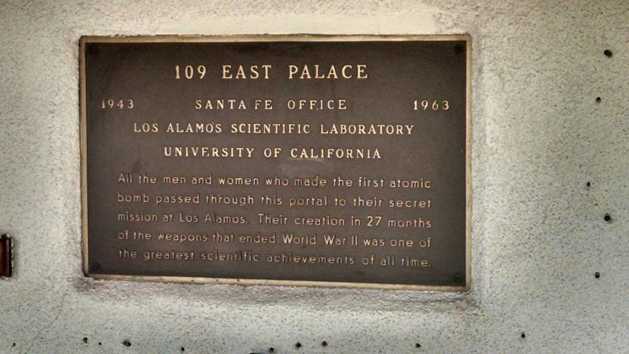Drive up the mountain that leads to Los Alamos, New Mexico, and the first thing you will see upon entering the town is a sign that proudly states “Where Discoveries Are Made!” This small city in northern New Mexico played a pivotal role in the Manhattan Project, and continues to function as a critical component in nuclear weapons and scientific development.
The city of Los Alamos itself was not founded until 1942, during which General Leslie Groves, the military head of the Manhattan Project and J. Robert Oppenheimer, the chief scientist, agreed on a location for a new secret laboratory to build the world’s first atomic bomb. Oppenheimer, who had spent numerous years in New Mexico, liked the site because it combined his two loves: physics and the West. For General Groves, it was isolated, and its location at the top of a mountain was perfect if any experiments went awry. [1] Almost immediately, roads were paved, buildings were constructed, and pre-fabricated government housing was erected as fast as possible. Senior personnel, such as Oppenheimer, received their own houses, located on “Bathtub Row,” named for the fact that these houses were the only ones with bathtubs in the entire town.[2]

As the Manhattan Project continued, the “Hill” expanded even more, but secrecy was paramount. Scientists coming to work on the Manhattan Project were first directed to an office at 109 East Palace Avenue in Santa Fe, New Mexico. From there, they received their security badges and were given final directions to Los Alamos from Santa Fe. However, the scientists and security personnel could not disclose their new location. Any mail which was sent to Los Alamos had to be addressed to “P.O. Box 1663, Santa Fe, New Mexico.” This secrecy did not stop those on “the Hill” to try and tell their loved ones where they were. A young military policeman sent his girlfriend a letter saying, “Oh, how I wish you were here with me in Box 1663.”[3]

By the early 1950s and with the nuclear threat of the Soviet Union looming, Los Alamos National Laboratory began to take on a more permanent status. As the town expanded, many of the original buildings which were involved in the Manhattan Project were torn down to make room for more permanent buildings, along with growing concerns about radioactive contamination. Eventually, the laboratory itself was moved to the south, and the town of Los Alamos remained to the north.
Today, several historical buildings remain in the town. “Bathtub Row” remains as one of the primary streets, along with the houses of J. Robert Oppenheimer and Hans Bethe. As both houses are currently private residences, tours are very rarely conducted. The current Los Alamos Community Building sits in the location of the old Tech Area, where many of the original Manhattan Project experiments were conducted. Across from the community building is the Ice House Memorial, where the cores for the bombs were stored temporarily during the Manhattan Project.[4]
Perhaps the best preserved and publicly open building is the Fuller Lodge, which was originally used as the main building for the Los Alamos Ranch School, an elite private boy’s school. During wartime, the structure functioned as a meeting place for the scientists and as housing. After the completion of the Manhattan Project, the military awarded the prestigious Army-Navy Excellence Award to all Manhattan Project personnel outside the lodge.[4] Across from Fuller Lodge is the Guest House, the private residence of General Groves and the current location of the Los Alamos History Museum.

In November 2015, the National Park Service officially established the Manhattan Project National Historic Park. Plans currently exist to incorporate two other historical sites into the park: “Gun Site” and “V site.” During the Manhattan Project, these two buildings were some of the most secretive sites at Los Alamos, as they were the final assembly sites for both bombs.[5] However, these buildings exist on Los Alamos National Laboratory property and are therefore currently not accessible to the public (For a virtual tour of Gun Site and V Site, see: https://www.youtube.com/watch?v=axkQ4UjTc8M).
Currently, Los Alamos is both a historical site and one that critically supports the mission of national defense. The Manhattan Project structures remain as ones that tell the story of a scientific marvel, which brought an end to the costliest war in human history, and the establishment of the Manhattan Project National Historic Park will ensure that these structures remain preserved for future generations.
[1] Jon Hunner, J. Robert Oppenheimer: The Cold War and the Atomic West (Norman: University of Oklahoma Press, 2009), 83.
[2] Jon Hunner, Inventing Los Alamos: The Growth of an Atomic Community (Norman: University of Oklahoma Press, 2004), 32.
[3] Hunner, Los Alamos, 41.
[4] Los Alamos Chamber of Commerce, “Los Alamos Historical Walking Tour,” Accessed July 14, 2016, http://www.visitlosalamos.org/historic-walking-tour/.
[5] Los Alamos National Laboratory, “Los Alamos History in Images,” Accessed July 14, 2016, https://lanl.gov/about/history-innovation/history-images/index.php.
[6] U.S. Department of Energy, “V-Site Assembly Building and Gun Site,” Accessed July 14, 2016, http://energy.gov/management/v-site-assembly-building-and-gun-site.
